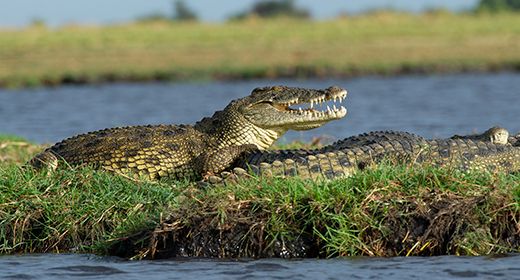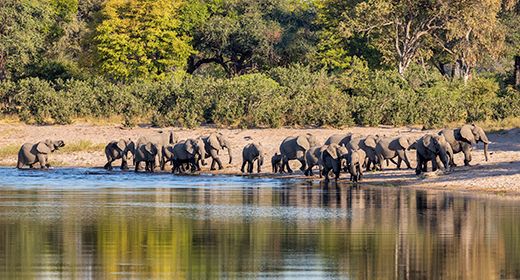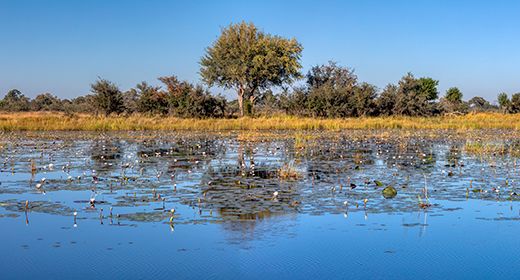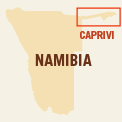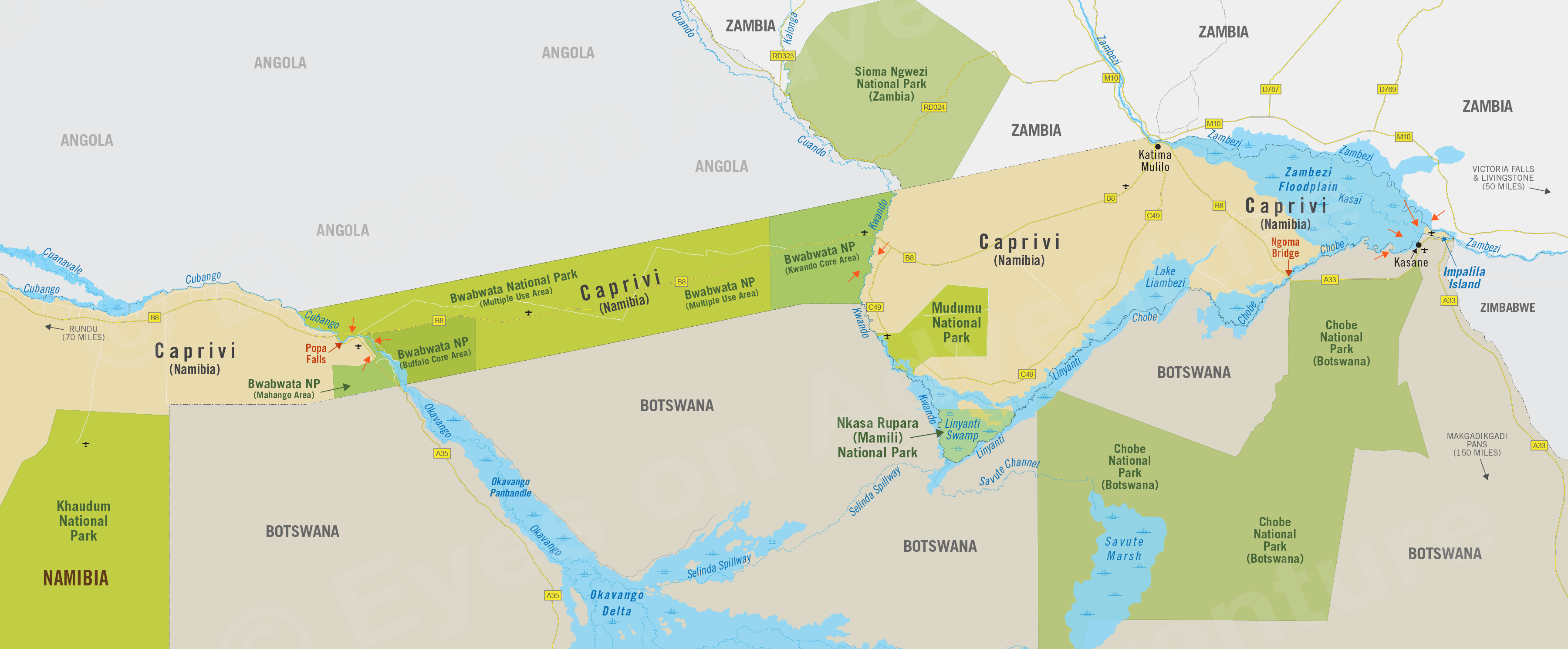Caprivi / Zambezi
(incl. Bwabwata NP, Mudumu NP, Nkasa Rupara NP, Khaudum NP, Chobe/Zambezi rivers)
Region Links: Caprivi / Zambezi, Damaraland & Waterberg, Etosha, Namib Desert & Sossusvlei, Skeleton Coast, Kaokoland & Kunene, Swakopmund, Windhoek
Highlights
- Experience a boating safari in the Zambezi Floodplain wilderness
- Nkasa Rupara NP is remote wetland and very similar to the Okavango swamps
- Explore Bwabwata NP, one of Africa's emerging wildlife destinations
- Visit Khaudum NP for a wild and remote safari experience
EOA Recommends: Chobe Savanna Lodge, Zambezi Mubala Lodge, Zambezi Queen Houseboat
Namibia's "Caprivi Strip" is the finger-shaped corridor of land extending along the northern border of Botswana for 280 miles (450 kms) and ending at the confluence of the Zambezi and Chobe rivers.
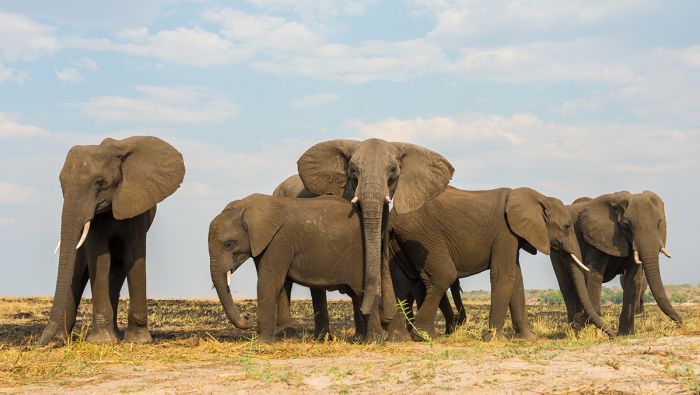
Elephants on the banks of the Chobe River, Caprivi Region, Namibia (Copyright © James Weis)
The Caprivi (now officially known as the "Zambezi Region") landscape is atypical of much of Namibia and much more similar to northern Botswana. The region is characterized by rivers, forests, and in the easternmost section, marshes and wetlands.
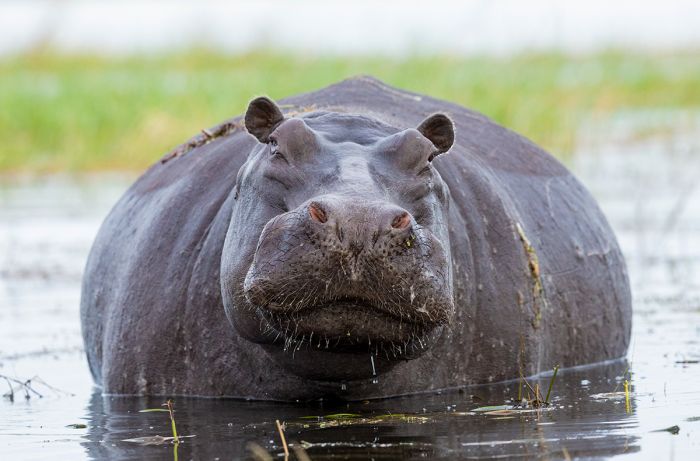
Hippo in the Chobe River, Zambezi Region of Namibia
In terms of wildlife and safaris, Bwabwata National Park has a ways to go to catch up to its neighbor to the south, Botswana, but it is moving in the right direction. The Zambezi floodplain portion of the region offers a superb safari experience in a river-based wetland and is one of Africa's most beautiful and remote destinations.
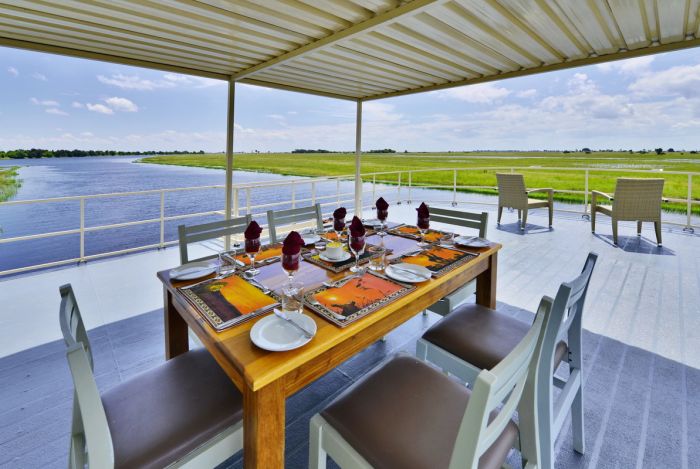
View from the Zambezi Queen houseboat in the Zambezi Floodplain
Lodges and Houseboat accommodations on the Chobe River are highly recommended for an experience unlike anywhere else in Africa. Elephants are the main draw here during the winter months (June-October), but birding is excellent year-round, especially during the summer (November-March). Fishing in the Chobe-Zambezi area is spectacular.
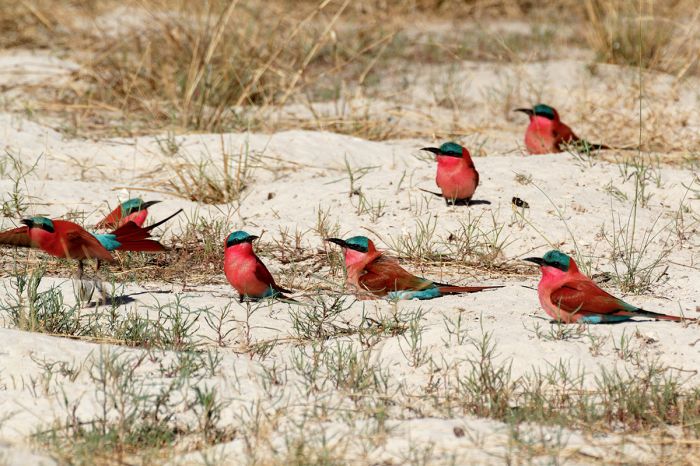
Carmine bee-eaters at their ground nests, Zambezi Floodplain, Namibia
Read More...
Bwabwata NP, History, Khaudum NP, Mudumu NP, Nkasa Rupara NP, Zambezi Floodplain
History
The long and thin shape of the "Caprivi Strip" is best explained by exploring its history. The Caprivi was a strategic region in the great "Scramble for Africa" by various European powers, chiefly Great Britain and Germany.
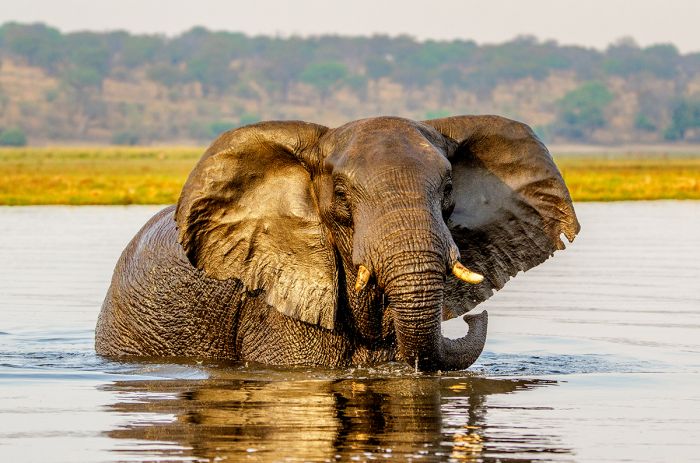
An elephant in the Chobe River, Eastern Caprivi, Namibia
When Germany declared South West Africa (present-day Namibia) as a German protectorate in 1884, the British, which already controlled South Africa's Cape, became concerned that Germany would link up with the Dutch Boers. The Boers controlled the northeastern portion of South Africa and Britain feared that a German-Boer alliance could cut them off from northern lands.
To block German colonial expansion further north, the British came to an agreement in 1885 with Khama, a powerful Bechuana tribal king, to form the British Protectorate of Bechuanaland (present-day Botswana). The Caprivi Strip was a part of this land deal.
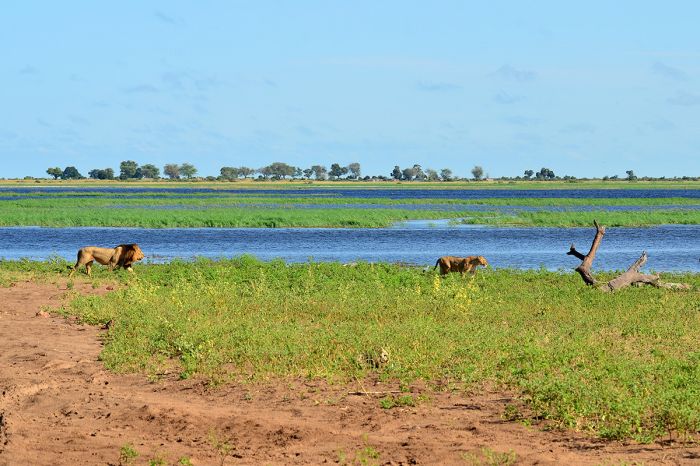
Lions walk along the Chobe River
In order to avoid conflict and potential war between the countries colonizing Africa, the Berlin Conference of 1884-1885 was convened in Berlin to put forth rules of competition by which the European powers were to be guided in creating new colonies in Africa. No nation was permitted to stake a claim to land without first notifying the other powers of its intention and no territory could be formally claimed unless it was effectively occupied. Of course, the rules were often broken and conflicts were common.
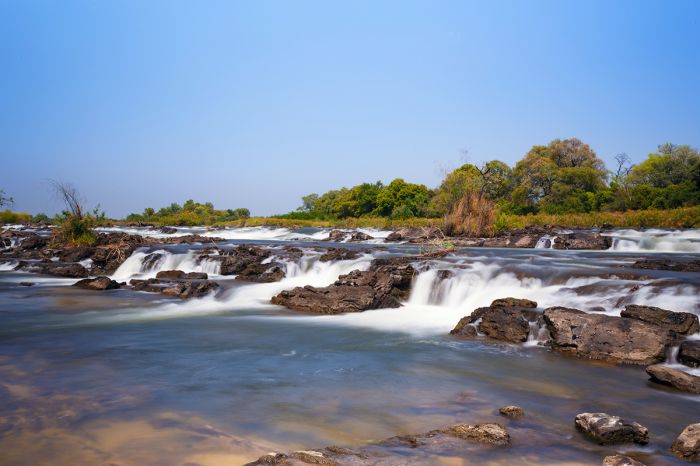
Popa Falls on the Cubango River in Namibia's Caprivi
In 1890, Germany laid claim to the British-administered island of Zanzibar, off the coast of Tanganyika (present-day Tanzania). This led to an agreement whereby Britain kept Zanzibar and in return, Germany was granted a vast strip of land along the northern boundary of Bechuanaland. The land was named the Caprivi, after Georg Leo von Caprivi, the Chancellor of Germany, and was annexed into German South West Africa.
This strategic land corridor gave Germany access to the Zambezi River and, they had hoped, ultimately to the Indian Ocean. Their goal was an empire spanning from the South Atlantic coast all the way to Tanganyika, which was already under German control. Unfortunately for the Germans, the British colonization of Rhodesia (present-day Zambia and Zimbabwe) effectively blocked them from being able to navigate to the Indian Ocean.
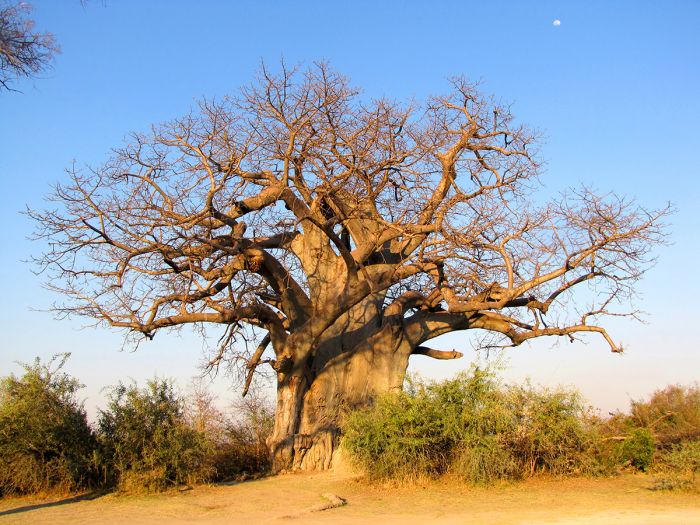
A baobab tree in Bwabwata National Park (Mahango Core Area)
After World War I ended, the Caprivi Strip was reincorporated into Bechuanaland and British control. In 1929, the Caprivi became part of South West Africa, which was then administrated by South Africa.
In 1959, Sam Nujoma founded a revolutionary group called the "South West Africa People's Organization" (SWAPO) to protest against the ruling South African government's apartheid policies. The Caprivi was the scene of violent fighting between Nujoma's freedom fighters and the South African Defence Force. Wildlife and people living in the Caprivi paid a huge toll.
In 1990, when the country gained its independence, Nujoma became the first president of Namibia.
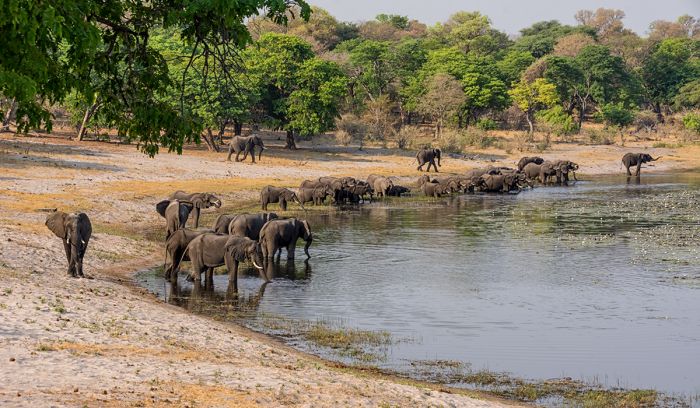
Elephants drinking in Bwabwata National Park (Kwando Core Area)
In 1999 Namibia agreed to assist Angola in their civil conflict against the rebel UNITA party. Namibia deployed troops to Angola and it allowed the Angolan army access to the Caprivi to launch attacks against the rebels. This brought the Angolan civil war across the border and into the Caprivi, which caused a major destabilization in the region. The conflict in Angola ended in 2002.
Today the wildlife that was poached and killed during the last decades of the 20th century has returned in good numbers, but the region is still relatively unknown and little-visited by tourists.
Bwabwata National Park
The central portion of Bwabwata area was originally declared as Caprivi Nature Park in 1963. It became Caprivi Game Reserve in 1966 and upgraded to Caprivi Game Park in 1968.
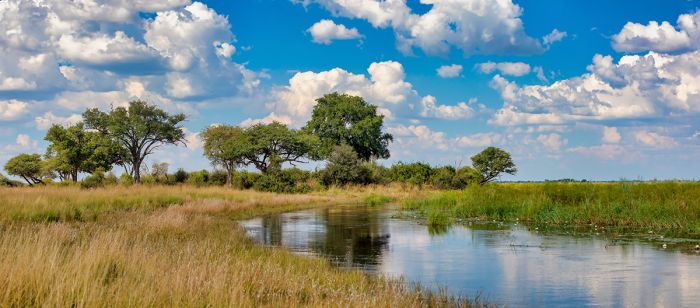
Scenery in the Bwabwata National Park (Kwando Core Area)
Unfortunately, as explained above, the area was the site of bitter fighting between Namibian freedom fighters and the South African Defence Force during Namibia's struggle for independence between 1966 and 1990. Due to the military operations, conservation in Caprivi essentially ended during these years and the park residents and wildlife paid a heavy price.
After independence in 1990, Namibia's involvement in Angola's civil war perpetuated destabilization in the Caprivi, continuing until 2002 with the Angolan ceasefire.
The Mahango Game Reserve, west of the Cubango river, was proclaimed in 1989. In 2007, Bwabwata National Park was created by merging Mahango Game Reserve, Caprivi Game Park, and a previously unprotected area along the Kwando River to the east.
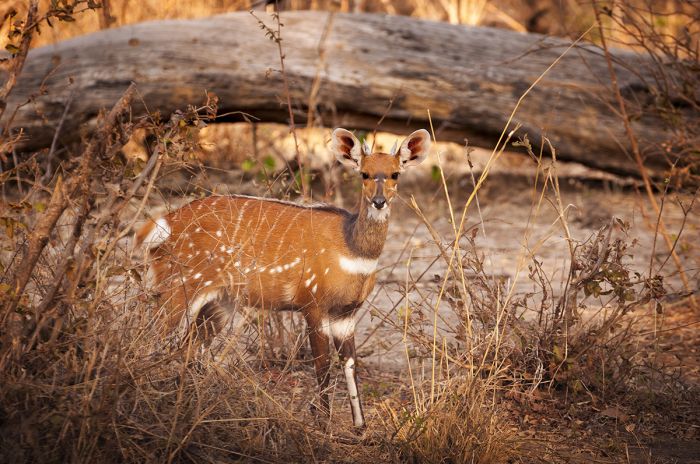
A bushbuck in Bwabwata National Park (Buffalo Core Area)
Rampant poaching during decades of conflict virtually decimated wildlife in the Caprivi, but since the end of the Angolan conflict in 2002, the Caprivi area has seen a slow but steady comeback in wildlife numbers. Elephants regularly move thru the Caprivi on age-old migration routes between Botswana, Angola, Namibia, and Zambia.
Bwabwata is divided into four areas. The central and largest section (previously Caprivi Game Park) is the "Multiple Use Area" and includes several sparsely populated villages. Wildlife is more limited here and tends to concentrate more on the eastern and western ends of Bwabwata, which both have major river systems.
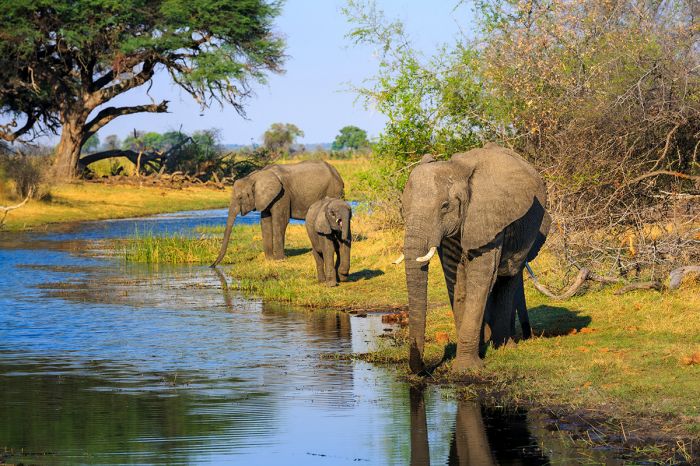
Elephants in Bwabwata National Park (Kwando Core Area)
The western end includes the Mahango Core Area (previously Mahango Game Reserve) and the Buffalo Core Area, each located on opposite sides of the Cubango/Okavango River system. Along the river are huge papyrus reedbeds and extensive floodplains, creating a rich wildlife habitat for animals such as red lechwe, hippo, crocodile, and sitatunga. Further from the river are dry forests and acacia scrub, attracting a diversity of wildlife including buffalo, elephant, sable, reedbuck, waterbuck, bushbuck, baboon, vervet monkey, and more. Bird life is spectacular.
The Kwando Core Area occupies the easternmost section of Bwabwata along the Kwndo River. This is a game-rich area, with a wildlife viewing experience that may include sightings of predators including lion, cheetah, wild dog, leopard, and spotted hyena. Elephants are common, as are giraffe, kudu, and buffalo. General game like impala and warthog is also good.
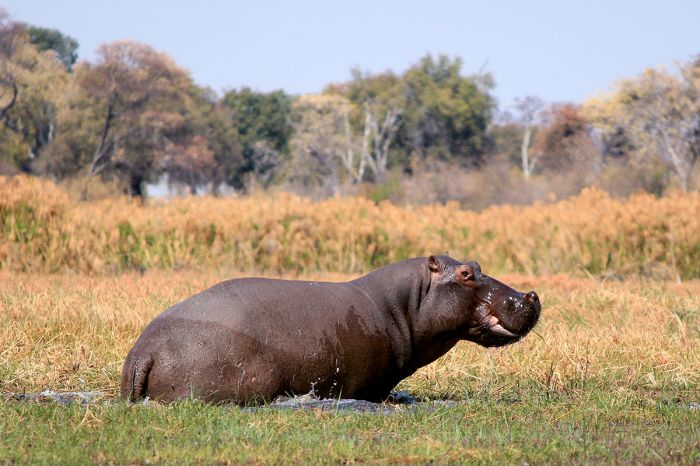
A hippo in Bwabwata National Park (Mahango Core Area)
Zambezi Floodplain
The area at the far eastern end of the Caprivi is surely its most beautiful and rich, with the confluence of the Zambezi and Chobe rivers creating a huge, seasonally inundated wetland. Impalila Island, a land wedge where the rivers join, is also the spot where the four countries of Zambia, Zimbabwe, Botswana, and Namibia meet.
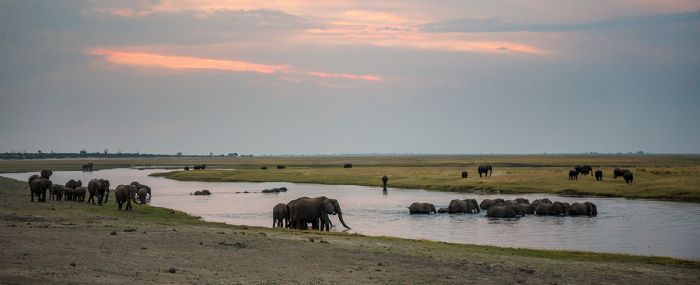
Elephants at dusk along the Chobe River
Several lodges are located along the northern bank of the Chobe River, offering outstanding safari experiences by boat in this gee-rich destination. The southern side of the Chobe (which is Botswana) also has safari lodges offering the same experience. Houseboats are also an option here, with multi-day excursions on the Chobe, Zambezi, and Kasai river systems. Smaller boats are used for safari activities and guests sleep in cabins on the houseboats.
Wildlife includes elephant, buffalo, red lechwe, hippo, crocodile, greater kudu, waterbuck, impala, and much more. Predators are often sighted on the banks of the Chobe, including lion, African wild dog, and spotted hyena. Wildlife on the Chobe, especially elephants, is most abundant during the winter months of July thru October. Once the rains, arrive in November, the wildlife disperses.
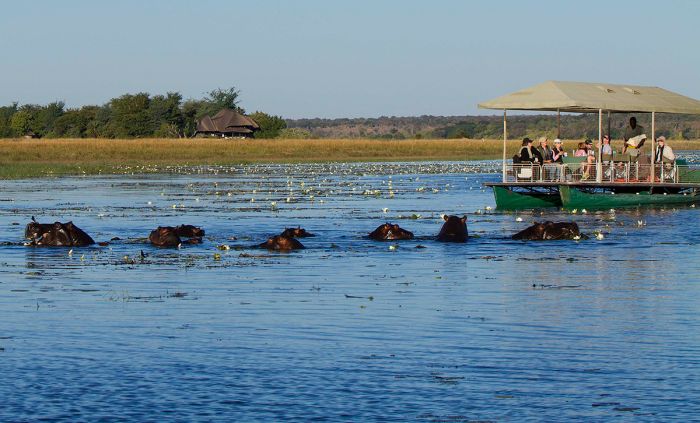
Boating safari on the Chobe River from Savanna Lodge in the Caprivi
Birding is excellent all year, with African fish-eagles, kites and other raptors, herons, egrets, skimmers, and more. Carmine bee-eaters colonies are located in several locations, including the biggest one at Zambezi Mubala. Fishing, especially for the African Tigerfish, is world-class in the area.
Mudumu National Park
Mudumu was once one of Namibia's richest wildlife areas, but years of unofficial trophy hunting decimated the animal populations. To prevent further abuse, Mudumu was declared a national park in 1990, shortly before Namibia's independence. Wildlife populations are slowly growing and Mudumu has great potential.
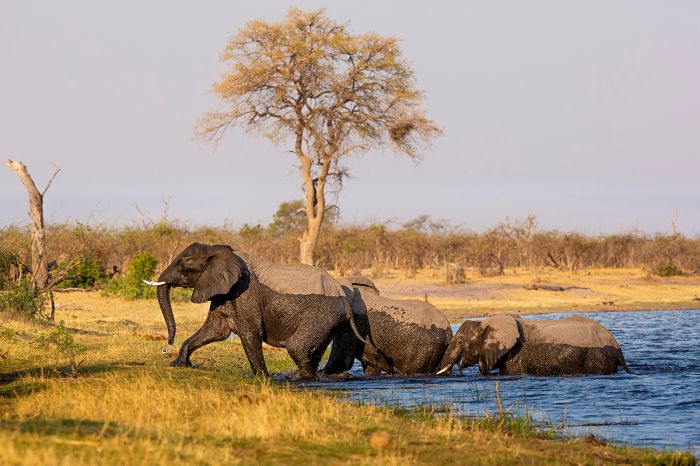
Elephants in Mudumu National Park, Namibia
The Kwando River forms Mudumu's western boundary and wildlife densities are highest here. Elephants are commonly seen in and along the river and other common species include hippo, buffalo, spotted hyena, crocodile, red lechwe, impala, zebra, wildebeest, and giraffe. Leopard, cheetah, lion and wild dog are sometimes seen. Birding is very good, especially along the river.
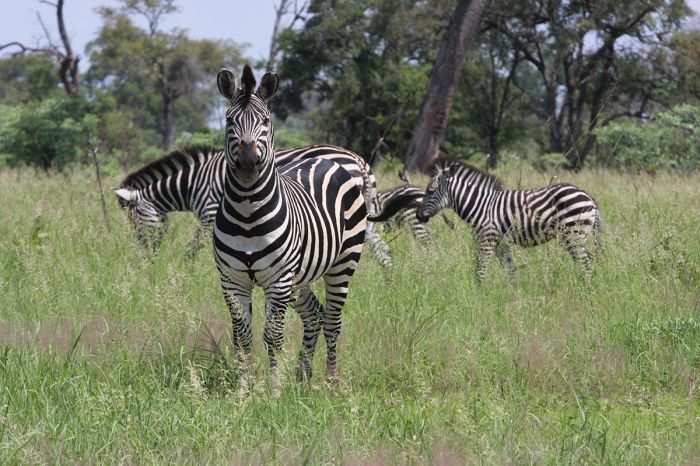
Burchell's zebras in Mudumu, Caprivi
Nkasa Rupara National Park
Formerly known as Mamili National Park and established concurrently with Mudumu NP in 1990, Nkasa Rupara protects Namibia's largest protected wetland area. The wetlands are formed by the Kwando river flowing south from Angola and spilling into a shallow trough, before flowing northeast as the Linyanti River.
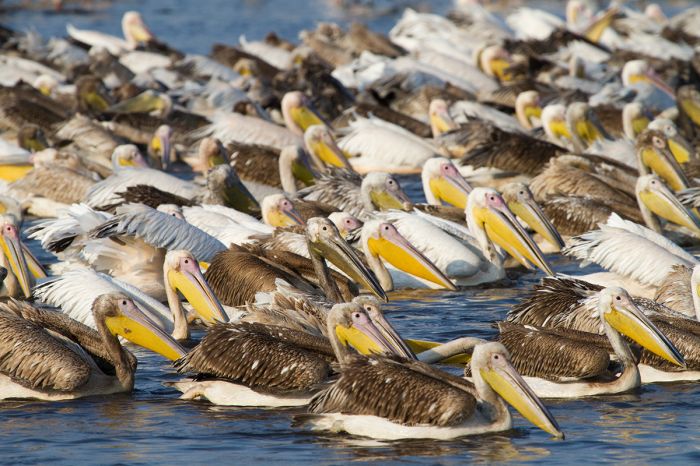
Great white pelicans in Nkasa Rupara National Park
The marsh consists of ever-shifting channels in papyrus reedbeds, two significant islands, and seasonally flooded plains. In many respects, this area is similar to much of Botswana's Okavango Delta, with water adapted species such as red lechwe and sitatunga antelopes at home here.
Elephant and buffalo are common, as well as hippo, crocodile, puku, reedbuck, impala, bushbuck, roan antelope, greater kudu, warthog, baboon, vervet monkey, and others. Predators are less common, but include lion, leopard, wild dog, cheetah, and spotted hyena. Birdwatching is nothing short of incredible.
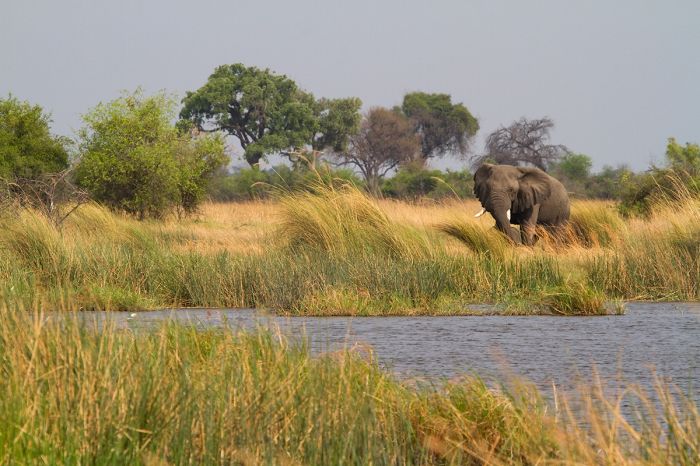
A bull elephant in Nkasa Rupara NP
Khaudum National Park
Khaudum is not technically part of the Caprivi, but is included here for its proximity to the region.
Proclaimed in 1989, this wild and rarely visited reserve features good wildlife in a mostly sand-dune ecosystem located on northern Namibia's eastern border with Botswana. Khaudum is seldom visited due to its very remote location, but for those who make the effort, it is a wild and beautiful destination.
The landscape consists of dry woodland and savanna growing on stabilized sand dunes, with some clay pans fed by a network of ancient riverbeds called 'omurambas'.
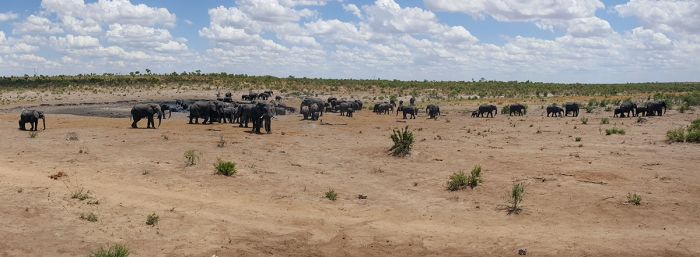
Elephants at a waterhole in Khaudum National Park, Namibia
Omurambas are rivers that rarely produce any water above ground other than occasional standing pools of water, which are the main source of life for the park's wildlife. The omurambas are linked to the Okavango in Botswana, which water replenishes the underground water table.
Wildlife includes elephant, roan antelope, tsessebe, eland, reedbuck, wildebeest, red hartebeest, greater kudu, oryx, warthog, ostrich and more. Predators that can be seen include lion, leopard, spotted hyena, and side-striped jackal. Khaudum is Namibia's best reserve for seeing African wild dog. Birding is also good, especially at the waterholes.
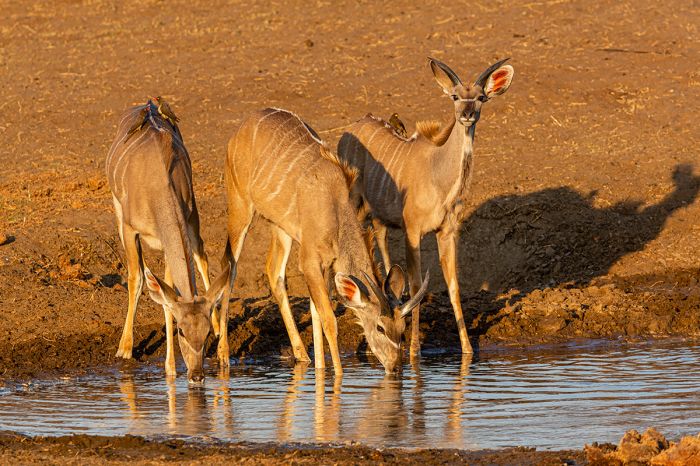
Greater kudus in Khaudum NP, Namibia
Read More...
Bwabwata NP, History, Khaudum NP, Mudumu NP, Nkasa Rupara NP, Zambezi Floodplain
Great Good Fair Poor
- Jan
- Feb
- Mar
- Apr
- May
- Jun
- Jul
- Aug
- Sep
- Oct
- Nov
- Dec
Seasons
The Caprivi has the same climate and seasons as northern Botswana. The winter months of May thru October are generally dry, with little to no rain. The temperatures are cooler except for October, which can be very hot. Summer is November thru April, with rains possible in November and December and peaking in January and February. Summer temps are hot and humid.
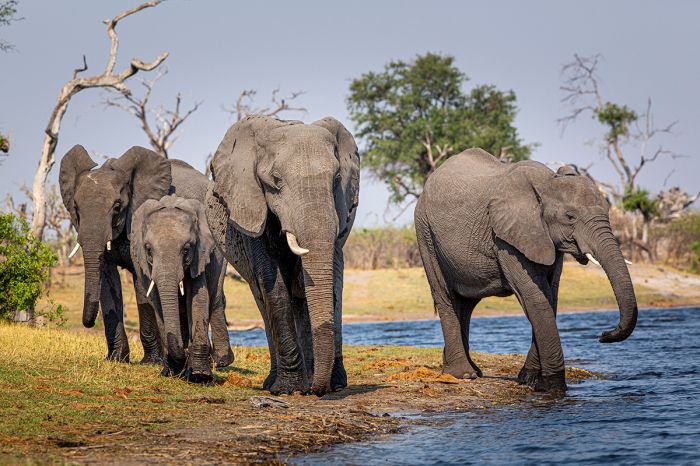
Elephants in Bwabwata National Park (Kwando Core Area)
Bwabwata, Mudumu, Nkasa Rupara
The central Caprivi, including Bwabwata, Mudumu, and Nkasa Rupara is the same as northern Botswana in terms of climate and game viewing seasons. The summer months bring rains, which start as early as November and continue thru Aril. The wettest months are January and February. Birding is best during the summer.
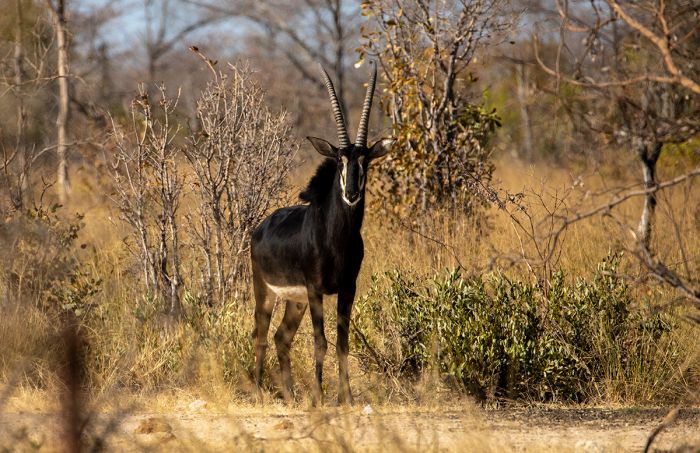
A sable antelope in Bwabwata National Park (Mahango Core Area)
During the rain-free winter months of May thru October, game viewing peaks along the permanent water in the Kwando and Cubango rivers. Elephants in particular are abundant along these waterways, but all of the herbivores and predators are much easier to find during the winter. October can be blisteringly hot.
Zambezi Floodplain, Chobe/Zambezi Rivers
Eastern Caprivi safaris are mostly limited to boating along the main waterways of the Chove, Zambezi and Kasai rivers. These rivers are crucial water sources for all the large predators in the region, particularly during the dry winter months from June thru October. During winter, the region is a haven for elephants, buffalo, kudu and a myriad of herbivores, that are forced to stay near the rivers to drink.
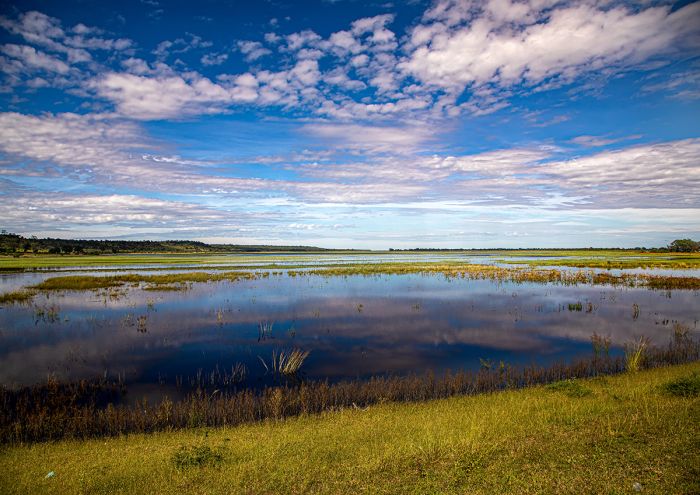
Scenery in the Zambezi Floodplain region of eastern Caprivi, Namibia
Once the summer rains arrive, usually in November and continuing thru April, most of the mammals disperse south into Botswana and north into Zambia, so game viewing is not nearly as good at this time. Birding in east Caprivi is good all year, but best during the summer months of November thru March.
Fishing is offered by most lodges in the Zambezi Floodplain and is a specialty in the region. The best fishing is from May through to December, with tigerfish a specialty.
Khaudum
Like most of Namibia, Khaudum is a year-round destination. The best time for large mammal viewing is during the dry winter months from June thru October when animals are forced to congregate around the waterholes and in the omurambas (river beds). Birding is best in the summer, from November thru April, when migrants arrive to breed. Roads can sometimes be difficult and muddy in summer if there have been rains.
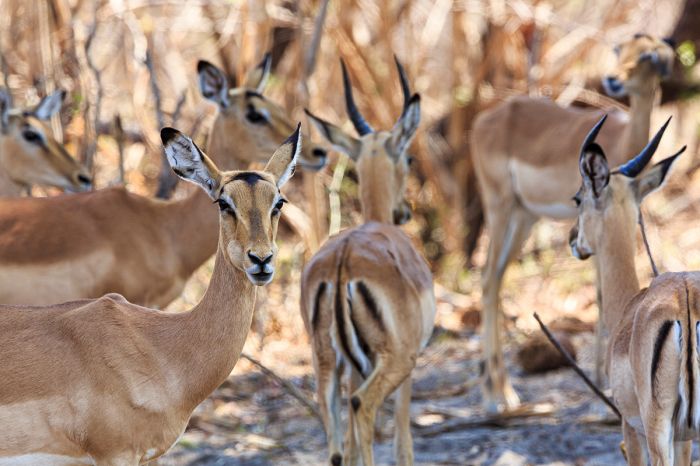
Impalas in Bwabwata National Park (Kwando Core Area)




